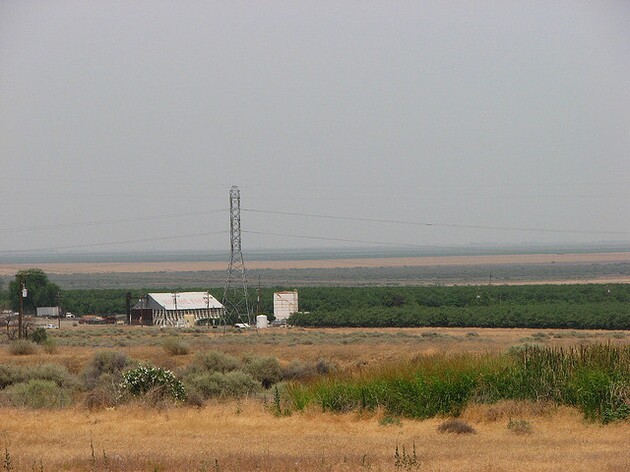Report: Retiring Toxic Farmland Would Save Money, Water, Delta Wildlife


An explanatory series focusing on one of the most complex issues facing California: water sharing. And at its core is the Sacramento-San Joaquin Bay Delta. Stay with kcet.org/baydelta for all the project's stories.
Retiring irrigated farmland on the west side of the San Joaquin Valley would increase the health of the Delta while saving water, and would be significantly cheaper than building additional aqueducts or tunnels, according to a new report released this month.
The report, prepared by the Oregon-based environmental consulting firm ECONorthwest, found that buying out 300,000 acres of irrigated farms in the Central Valley Project's semiarid San Luis Unit in the San Joaquin Valley would cost between $540 million and $1.02 billion dollars, a fraction of the amount currently proposed to build new infrastructure in the Delta to water those acres.
As an additional benefit, the buyouts would end further contamination of water downstream with the toxic element selenium, which now ends up in the Bay Delta food chain.
The report by ECONorthwest was commissioned by the groups Food & Water Watch, Restore the Delta, and California Water Impact Network. The groups say that irrigating the land discussed in ECONorthwest's report uses 455,000 acre-feet of Central Valley Project water per year, more than three-quarters the water Los Angeles uses in a typical year.
That water, once it's used to irrigate land in the San Luis Unit, picks up elements such as boron, chromium, molybdenum, and selenium that accumulate in the upper layers of soil after years of irrigation. Runoff from the fields then enters tributaries of the San Joaquin River, eventually entering the Delta.
The elements mentioned above are all potentially toxic to living things. Selenium, a vital nutrient in small doses but toxic in larger amounts, has been a concern in the area for decades. Selenium-laden drainage water from the San Luis Unit once was flushed down a canal called the San Luis Drain into a reservoir in the the Kesterson National Wildlife Refuge, where the element poisoned wildlife. After images of deformed waterfowl born at Kesterson made the national news in 1984, the San Luis Drain and Kesterson were both closed. Since then, selenium runoff has entered the San Joaquin River through other channels, as farmers and regulators have argued over how to dispose of drainage water from selenium-tainted lands in the western San Joaquin Valley.
The dispute made it to the legal system shortly after the San Luis Drain was closed, with farm interests claiming that they were owed a way to discharge their selenium-laden wastewater. The San Luis Drain had originally been intended to reach all the way to the Delta, a notion to which environmentalists and Delta-based water agencies understandably objected. In 1994 a federal court judge ruled that the Bureau of Reclamation violated the law by not providing farmers with a way to get rid of their drainage water. The judge -- the now-retired Oliver Wanger, whose career held many major Central Valley water-related decisions -- specifically mentioned completing the drain all the way to the Martinez area as a feasible option.
A 2000 decision by the Ninth Circuit dialed that lower court decision back a bit, saying Reclamation was obliged to provide a solution without endorsing a completed San Luis Drain. The Bureau of Reclamation has been examining the possibility of a wastewater treatment plant as an alternative to dumping selenium into the Delta.
With or without the drain, selenium does eventually get to the Bay Delta, where it is avidly taken up by the invasive clams that cover the floor of both freshwater and saltwater portions of the estuary. Animals that eat the clams, including the declining white sturgeon, can suffer from selenium poisoning as a result. Selenium has been found to interfere with sturgeon reproduction; it's reasonably safe to assume the element has similar effects on other wildlife.
You might think that a proposal to retire farmland permanently as a way of reducing pollution and saving water would draw the ire of farming interests. But in the San Luis Unit, between 80,000 and 100,000 acres of farmland have already been retired voluntarily, with the willing assistance of the irrigation districts that served those lands.
That includes the Westlands Water District, which delivers water to 87 percent of the San Luis Unit. In 2002, Westlands published a brochure that lauded the benefits of voluntary retirement of contaminated farmlands, calling it "a reasonable alternative to endless controversies that produce fractious debate and little resolution" and "the most cost-effective alternative to relieve the Bureau of this costly and difficult-to-achieve drainage obligation."
The Bureau of Reclamation chose not to pursue aggressive farmland retirement. According to the ECONorthwest report, between 279,000 and 299,000 acres of so-called "drainage-impacted lands," where a shallow layer of clay impedes percolation of water deep into the subsoil remain available for retirement. It's those lands, where irrigation water cannot carry selenium and other "salts" into the subsoil, that pose the worst toxic runoff risk.
And according to the report, those lands could be retired by buying out farmers for between $1,931 and $3,440 an acre, for a total cost of between $540 million and $1.2 billion.
That's a significant chunk of change, but it's competitive with building a complete San Luis Drain. What's more, retiring those farmlands would make the 455,000 acre-feet of Delta water they use each year available for other purposes.
"Spending one billion dollars to take these selenium-laced, unsustainable lands out of production and cutting the water rights that go with them saves Californians water money," said Food & Water Watch's California director Adam Scow. "Retiring these west side lands makes a lot more sense than spending $67 billion to build Governor Brown's outdated tunnels to support corporate agribusiness."


